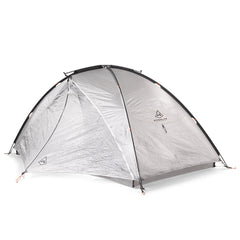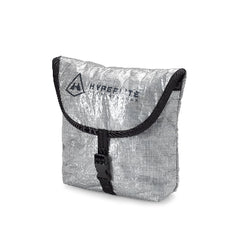Words and Photos from Carl “Professor” Stanfield @prof_carl

“A journey of a thousand miles begins with a single step.” Wise sentiment though it may be, I’d dissent from this ancient Chinese proverb by reflecting on all that goes into a backpacker’s career before that boot or trail runner first has the pleasure of striking the earth. The internet culture has made backpacking sexier than ever, and new hikers jump into the sport every day. Some folks are picking up a new weekend hobby, while others are venturing into multi-month treks, with plenty more somewhere in between. As someone who made the jump from weekend warrior to yearlong nomad, here’s how I see that transition often shaping.

DREAMER
We all have our own calls to backpacking, but what drew me into the sport was the epic fantasy of adventure. I got into the sport a while ago, back in the late 2000s when YouTubers were few and far between. The big draw for me was quite literally an adventure fantasy. I wanted to experience the closest thing I could to the fictional treks and journeys I grew up entertained by. Even without the fate of the world hanging in the balance of whether or not I could successfully reach my destination, the concept of venturing through nature with everything I needed to survive had me intrigued. Backpacking just seemed cool, inspiring, badass, magical. And I think that’s what draws a lot of people into it: a modern-day adventure fantasy, a personal challenge of human vs. wild.
Once the spark hits, it’s easy to fall down a rabbit hole. There are many excellent written stories of personal epics and virtually infinite accounts of backpacking treks online. One may even feel called by the allure of their own local mountains, silently beckoning from the horizon during their daily commutes. I vividly remember being 18 and dreaming about a solo survival journey in my local “woods.” This dreaming stage can go on forever, but to effectively scratch the itch, more steps must eventually be taken.

COLLECTOR
After dreaming up an adventure, the next step for me was gathering the tools to pull it off. Some folks might be fortunate enough to have access to borrow gear from a friend or outfitter. Others might just jump right into building their own collections. Whatever it is, assembling the kit is a huge step towards actually getting those feet out onto the trail. Today, there is virtually an endless array of gear options to sort through to figure out what’s going to keep a person alive and happy out there. And depending on what YouTube rabbit hole a person falls into, it’s easy to get convinced just about anything is necessary on trail, or vice versa (though fortunately, if you’re here reading this, you’ve at least fallen down a rabbit hole on the lighter end of the spectrum).
For me, gear was the other piece of the puzzle that convinced me this was something worth obsessing over. From a young age, I’d always loved little multi-use, functional trinkets. Inflatable sleeping pads, miniature multi-tools, and stoves that could fit in the palm of my hand got me all kinds of excited. I spent my first year and a half as a backpacking hopeful, dedicating birthdays, Christmases, and spare funds towards assembling my collection. To this day, I think it’s one of the most fun parts of the whole backpacking experience.
EXPERIMENTALIST
The gear is collected, the dreams are drum, and there’s only one thing left to do. At some point in a backpacker’s career, they’ll finally get to (have to?) backpack. That first trip is probably the scariest part of the whole process. You can camp, and you can hike, but until you’ve loaded your pack and walked into the woods, there’s just no way to really know what it’s going to be like to backpack. To this day, I think one of the hardest trips I’ve ever done was my very firsta 3daysy,a 30-something-mile trek in the Smokies. At 18, with a fully loaded 50-pound pack, I was bounding up switchbacks the first few hundred yards. The adrenaline of finally being on the trail and the novelty of actually wearing a huge pack like I’d seen on TV carried me for a time, but it didn’t take long before the weight took its toll. As far as expectations vs. reality goes, that first trip was the most difficult to date. Call it the naivete of youth, but the main thing that stands out from my first trip was the shock of the extent of the suffering.
In retrospect, I’m extremely grateful that first trip was so physically miserable. I firmly believe in the power of experiential education, and that’s as true in backpacking as it is anywhere. The biggest thing I think people are experimenting with on their first backpacking trip(s) is comfort. Everything in backpacking centers around temporarily readjusting a person’s comfort and discomfort thresholds. Literally everything: walking, sleeping, eating, bathrooming, exposure, every single aspect is different and less comfortable than the norm. It’s a lot to get used to on trail, but once a person can start to overcome those challenges, the real magic starts to happen.

REFINER
After that first trip (and maybe/probably even the next few after that), a backpacker begins to refine their systems. Now that they’ve felt the pain of that 50-pound pack, the idea of leaving the 2-pound chair at home starts to sound a bit more reasonable. I’ve heard it said many times that people “pack their fears” when backpacking, and my experiences lead me to believe that is usually true. Naturally, the best remedy for that fear is confidence. Too much confidence early on can be dangerous, but it’s much more common to have too little and to be packed down with pounds and pounds of fear. A map and compass won’t save a person if they don’t know how to use them. Extra sets of hiking clothes won’t keep a person from being dirty. Deodorant won’t prevent a person from becoming filthy. Most tips like this are much more easily understood once they have been personal lived experiences, so the best way to learn them is by just getting out there and feeling it all.

GAMBLER
Once a backpacker has done some refining, they head into a high adrenaline stage of their career and get to begin gambling. Now, hear me out. I don’t think any hiker should embark on a trip in which they’re uncertain of their life. However, I do believe that trip plans can become more grandiose once backpackers know how to take care of themselves in the backcountry. Distance covered, time on trail, depth of wilderness are all factors that can change both the levels of difficulty of a trip and also the rewards of the adventure. Some may even be called to go all in on themselves and embark on a thru hike, stringing together dozens, hundreds, or even thousands of miles in a single trip.
The “gambling” can even take the shape of taking other people along. The gamble is, of course, not on their lives, but in providing an enjoyable, rewarding, safe experience to another person, bringing them into the fantastical world of backpacking.
MASTERY
Finally, after racking up miles on feet and nights on the ground, a backpacker becomes a master of the sport. Does this mean they’ve perfected backpacking? No. Does it mean they’ve learned everything they can? Absolutely not. A hiker has mastered backpacking when they’ve mastered the balance of being comfortable while being uncomfortable. They know how to safely navigate obstacles and difficulties in the backcountry. They are humble, they respect nature, and most importantly, they are willing and eager to learn from the place and people that make backpacking the rewarding, joyous adventure that it is.























